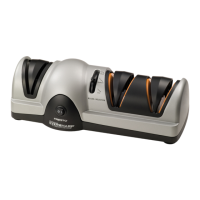3
Sharpening Procedure:
Begin by placing the knife in the left slot of the stage in use (Fig. B). The side of the blade
should rest against the outside face of the blade guide slot and the cutting edge should make
contact with the sharpening wheel (Fig. C).
CAUTION! Never insert the tip of the knife into the blade guide slots first and push through.
This could damage the knife sharpener and your knife.
Using only light downward pressure, slowly pull the knife towards you through the slot,
making sure to keep the cutting edge parallel with the table or the countertop, except when
sharpening the tip of the blade. If the motor slows while pulling the knife, apply less down-
ward pressure.
To sharpen the tip, lift up on the knife handle slightly as the curved portion of the blade is
drawn through the slots.
Note: The greater the curve on the blade, the more you will need to lift up on the handle.
The less the curve, the less you will need to lift up on the handle. Certain blades may not
have a curve and therefore it will not be necessary to lift up on the handle as you draw the
tip through the slots.
Draw the knife through the left and right slots three times, alternating passes between the two slots. Allow approximately one second
for each two inches of blade when drawing the knife through the slots. For example, if sharpening a knife with a 6-inch blade, you
should take approximately three seconds for each pass.
6. Before using the knife to slice food, always wipe the knife blade with a damp cloth to remove any metal filings that may have been
deposited during the sharpening process. CAUTION! To avoid injury, handle knives with extreme care.
7. If the knife does not easily slice food, repeat Stages 2 and 3. CAUTION! Do not run fingers along edge of knife to check sharpness.
8. When sharpening is complete, turn the unit off by pressing the symbol “O” on the ON/OFF switch. Metal filings may be present on
the table or countertop and may be wiped clean with a damp cloth.
Questions and Answers
How often should I sharpen my knives?
Use Stage 3 to hone the knife prior to each use if you want to maintain a razor-sharp edge. After extensive use, if you have honed the
knife and it no longer slices food with ease, run the knife through Stages 2 and 3.
How do I get an even edge on my knife?
To get an even edge when sharpening, be sure to place the knife in the slot so the side of the blade rests against the outside face of the
blade guide (Fig. B) and the cutting edge makes contact with the sharpening wheel (Fig. C) as you’re drawing the knife through the slot.
The outside face of each sharpening slot acts as a guide to insure that the knife is positioned at the perfect sharpening angle.
Allow adequate time for sharpening. When drawing the knife through the slots, allow approximately one second for each two inches of
blade. For example, if sharpening a knife with a 6-inch blade, you should take approximately three seconds for each pass. Pulling the
knife through too quickly may result in an uneven edge.
When sharpening the tip of the blade, lift up on the knife handle slightly as the curved portion of the blade is drawn through the blade
guides. Note: The greater the curve on the blade, the more you will need to lift up on the handle; the less the curve, the less you will
need to lift up on the handle. Certain blades may not have a curve and therefore it will not be necessary to lift up on the handle as you
draw the tip through the slots.
How can I tell if my knife is sharp?
Use it to slice food. If the knife does not slice the food with ease, it needs additional sharpening. Repeat Stages 2 and 3. If the knife is
extremely dull, repeat Stages 1, 2, and 3. CAUTION! Do not run fingers along edge of knife to check sharpness.
My knife is not sharp and I’ve gone through the whole knife sharpening procedure twice. What am I doing wrong?
Although unusual, there are times when you will have to repeat Stages 1, 2, and 3 more than once. This may occur during the first
sharpening of a knife that has been improperly sharpened by another process previously. It may also occur when sharpening knives of
tempered steel which have extremely hard blades, such as some hunting knives.
To sharpen these types of knives with this knife sharpener, simply continue to repeat Stages 1, 2, and 3 until the knife cuts food easily.
Depending on the condition of the blade, you may have to repeat the process several times. In extreme cases, this could be 10 times or
more. This extended process will only be necessary the first time you use the knife sharpener for this type of knife. Thereafter, you will
be able to sharpen your knife following the normal sharpening procedure.
Blade against outside face of left slot
Fig. B
Fig. C
Outside face
of left slot
Outside face
of right slot

